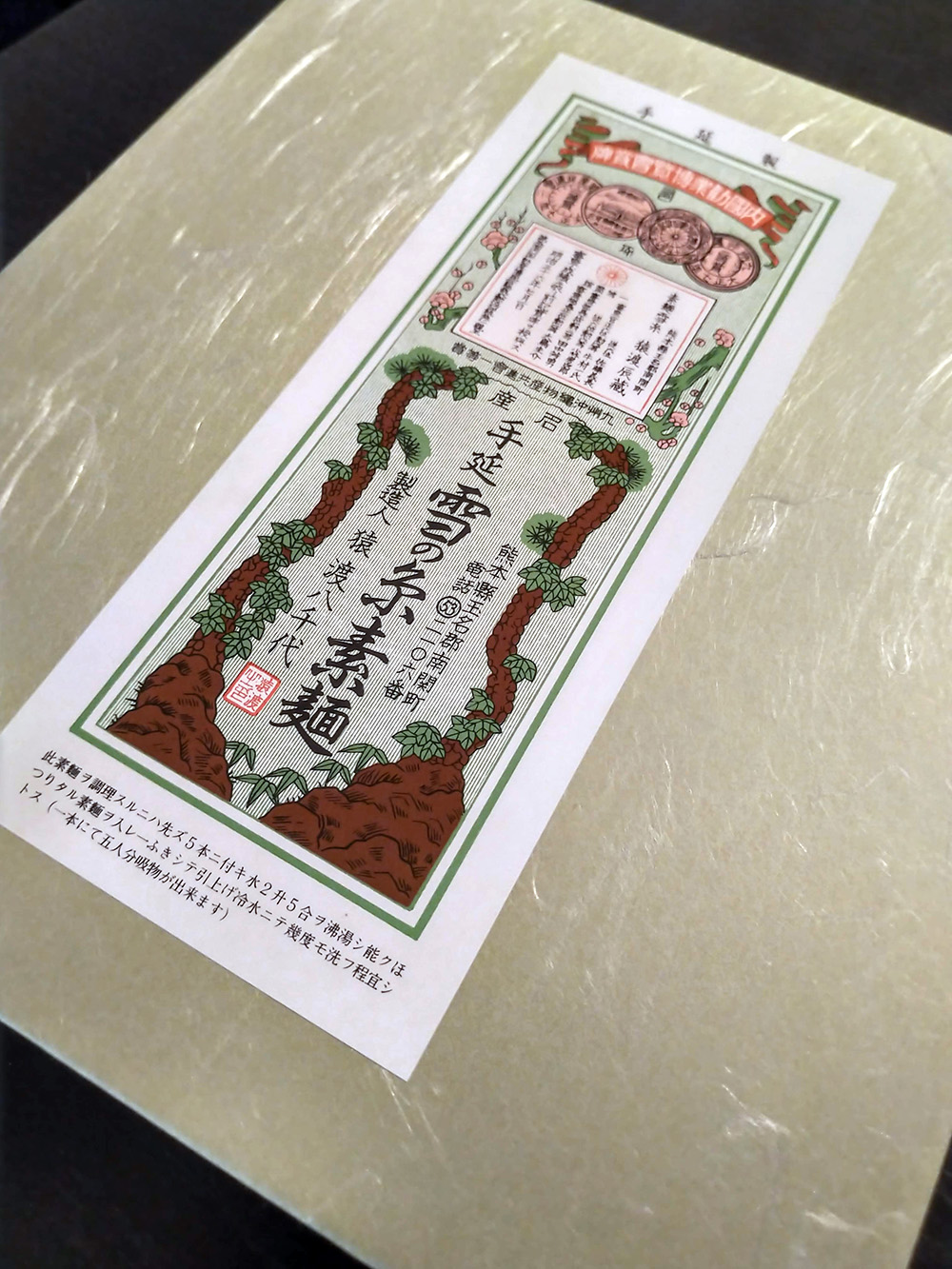手延素麺 雪の糸
熊本県南関町は、江戸時代から手延べの南関素麺が名物らしい。当時の肥後藩主、細川氏が江戸時代では徳川幕府へ、明治では明治天皇に、上京するたびに献上していたそうな。
Nankan-somen, a kind of hand-stretched noodles called “tenobe somen”, is a famous product which has been produced in Nankan-machi, Kumamoto since Edo era. Hosokawa Clan, Lord of Higo-han at that period, always dedicated this somen as a gift to Tokugawa Bakufu in the Edo era and Emperor Meiji in the Meiji era when they visited to the capital.

以前「世界!ニッポン行きたい人応援団」というテレビ東京の番組で、外国人が猿渡製麺所を訪問していたのがきっかけでこの素麺を知って、ふるさと納税で試してみた「雪の糸」。猿渡製麺所では、2020年現在、9代目の84歳の井形朝香さんと、職人さん数名で、今でも江戸時代から受け継がれている伝統的な「手延べ」製法で、機械を一切使わずに丁寧に作り上げているという。
I happened to know the somen on the TV show called “Sekai Nippon Ikitai hito Ouendan (Supporters for the person in the world wishing to come to Japan)”, featured an American wishing to come to Japan to see how to make the Nankan-somen at Saruwatari Seimensho, one of the famous somen manufacturer in the area. Then, I ordered “YUKINO-ITO”, signature somen at Saruwatari Seimensho. In 2020, Ms IGATA Asaka, the “84-year-old” 9th generation of the Nankan-somen master is making this somen there with some artisans. Even now, Nankan-somen is made by hand, without using any type of machines – “tenobe” means “stretched by hand” and it is traditional formula for making somen carried on from Edo era.
試してみた感想は・・・
普段うちで食べる素麺は、揖保乃糸。それとくらべて、細くて長い!いや、「超細くて、超長い!」のだ。同梱されてる注意書きにあるように、半分に切ってから茹でること!長いままだと、食べる時に大変なことになりますよ(少し試したけど、本当に長くてすすれず、噛みきることも難しく、食べにくすぎた!)。
“IBO-no-ITO” is the most familiar somen to me. Comparing to that, “YUKI-no-ITO” is too thin and too long to eat without cutting it. You should read the memo enclosed in the package – you must cut the somen in half before boiling it. If you boil it before cutting it, you will be in trouble when you eat it…
食感は「もちもち」。冷やし素麺で食べたけれど、小麦の風味は揖保乃糸のほうが強く感じる。これは、煮麺でいただいたほうがいいかもしれない。超~細いけれど、茹でても伸びにくい。冷たい麺を少しずつとってツユにつけて食べるよりは、温かいお出汁にひたひたと浸かった麺をすするほうが、この麺の良いところを感じられそう。近々、温かい麺を試したい。
The texture was chewy. I tried cold somen. This YUKI-no-ITO’s Komugi (wheat) flavor was a bit weaker than IBO-no-ITO. I thought I should make it hot Nyumen. Though each noodle is too thin, it doesn’t get too soft. I think it is much better to make it hot – it should go well with hot “dashi (soup)”. I’ll try hot one next time.

「雪の糸」の乾麺の束も「手延べ」が感じられる。レトロな箱も、雰囲気あるよね。
井形さんの跡を継ぐ10代目となる人も見つかっているようですね。これからも魅力的な「雪の糸」を手延べして頂きたい。
Taking a glance at a bundle of the dried YUKI-no-ITO somen, you will see it is “made by hand”. The package has retro atmosphere. The master, Ms. IGATA has found the person she would like to inherit her technique and decided to pass the baton to the 10th generation. I hope they will keep traditional and valuable hand-made “YUKI-no-ITO” in Nankan, Kumamoto.
煮麺で食べてみた
2020年12月。温かいお出汁が細い麺の一本一本ををふんわりさせて、口当たりがよくなる。冷やし素麺にしたときよりも小麦の風味を感じた。麺が伸びにくくて、コシが失われない。これはよい!是非、煮麺でお試しを!
Update on December 2020:
I made Nyumen, hot somen. Hot “dashi (soup)” made each thin noodle soft in texture (never gets soggy, though) , I was able to feel the flavor of Komugi (wheat) more this time than the last time I made it cold somen. I recommend to have a hot YUKI-no-ITO Nyumen.


コメント